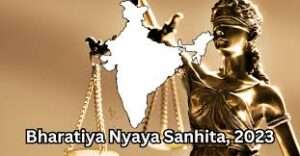
This article has been written by by Janani A, student at Tamil Nadu Dr Ambedkar Law University, SOEL

Abstract
This abstract examines Chapter XXIX of the Bharatiya Nagarik Suraksha Sanhita ( BNSS), a fictional codified criminal law system in India. The chapter focuses on ensuring fair and transparent judgements in criminal trials. Key aspects analyzed include methods for pronouncing judgements, the content and language requirements, and additional orders addressing victim support, witness protection, and probation for first-time offenders. By outlining these procedures, Chapter XXIX promotes clear communication of court decisions, prioritizes victim well-being, and fosters a balanced approach to criminal justice within the BNSS framework.
Howdy, you all! Welcome to your page of knowledge. You will find different legal blogs, the latest news, current affairs, and many more on this channel. This is the initiative to develop the knowledge of the law in the world, especially for you.
Keywords: Criminal Justice System, Judgement Pronouncement, Judgement Content, Victim Compensation, Witness Protection,
Introduction
The criminal justice system relies heavily on fair and transparent procedures to deliver justice. One crucial aspect of this fairness is ensuring clear and well-defined processes for judgements in criminal trials. This is precisely what Chapter XXIX of the Bharatiya Nagarik Suraksha Sanhita ( BNSS) accomplishes. This chapter outlines the legal framework surrounding judgements, dictating how they are pronounced, what information they must contain, and how additional considerations like victim support and witness protection are addressed. By delving into this chapter, we gain valuable insights into the BNSS’s commitment to a balanced and just criminal justice system.
Pronouncing the Judgement (Section 392)
The judgement must be delivered in open court by the presiding officer (judge). This can be done by:
- Reading the entire judgement
- Delivering the whole judgement orally (in shorthand)
- Reading the operative part (consequences) and explaining the judgement in a language understood by the accused.
- A copy of the judgement needs to be provided to the parties (accused/advocate) free of cost.
- If the accused is in custody, they must be brought to court to hear the judgement (or via audio-video).
- If the accused is not in custody, they are required to be present for the judgement pronouncement, unless special permission is granted (e.g., fine only sentence and no prior attendance issues).
Content and Language of the Judgement (Section 393)
- The judgement must be written in the court’s language.
- It should mention the points for decision, the court’s decision and the reasons behind the decision.
- It should specify the offence (if any) and the relevant law section under which the accused is convicted. It should also mention the sentence.
- If the accused is acquitted, the judgement should specify the offence for which they are acquitted and order their release.
- In case of a death sentence or alternative sentences (death/life imprisonment/imprisonment for years), the judgement needs to explain the reasons for the specific sentence awarded.
Order for Notifying Residence of Previously Convicted Offender (Section 394)
- This section allows courts to order someone convicted of a serious offence (3+ years imprisonment) to notify their residence and any changes in residence after release, for up to 5 years.
- This provision applies to criminal conspiracies, abetment and attempts to commit such offences.
- The order can be cancelled if the conviction is overturned.
- Appellate courts and higher courts can also issue such orders.
Order to Pay Compensation (Section 395)
- When a court imposes a fine (or a sentence including a fine), it can also order the fine to be used for various purposes:
- Defraying prosecution costs
- Compensating victims for loss or injury caused by the offence
- Compensating families in case of death caused by the offence
- Compensating someone who unknowingly received stolen property
- Compensation cannot be paid before the appeal period ends or until the appeal is decided (if applicable).
- The court can also order the convict to pay compensation directly to the victim.
- Appellate courts and higher courts can also make such compensation orders.
Victim Compensation Scheme (Section 396)
- Each state government, in coordination with the central government, needs to prepare a scheme to provide funds for compensating victims of crime who need rehabilitation.
- Courts can recommend compensation for victims.
- The District or State Legal Services Authority will decide the amount of compensation awarded.
- Trial courts can recommend compensation even in acquittal cases where the victim needs rehabilitation.
- Victims or dependents can apply for compensation if the offender is not identified.
- Legal Services Authorities can award compensation after an enquiry within 2 months.
- Authorities can also order immediate medical aid for the victim free of cost.
- Compensation by the state government is in addition to any fines paid to the victim under other sections.
Treatment of Victims (Section 397)
- All hospitals (public/private) must immediately provide free first-aid or medical treatment to victims of certain offences.
- These offences include assault, theft, criminal breach of trust, sexual offences against children etc.
- The hospitals must also inform the police about such incidents.
Witness Protection Scheme (Section 398)
- Each state government needs to prepare and notify a Witness Protection Scheme to ensure witness safety.
Compensation to Persons Groundlessly Arrested (Section 399)
- If a magistrate finds that someone was arrested without sufficient reason, they can award compensation to the arrested person for their time and expenses.
Order to Pay Costs in Non-Cognizable Cases (Section 400)
- Courts can order convicts in non-cognizable cases (petty offences) to pay some of the prosecution costs, including process fees, witness expenses, and lawyer fees.
- Appellate courts and higher courts can also make such orders.
Order to Release on Probation of Good Conduct or After Admonition (Section 401)
- This section allows courts to release first-time offenders on probation instead of punishment under certain conditions.
- Offenders must be above 21 years old (unless female or minor)
Conclusion:
Firstly, it ensures clear communication of the court’s decisions. By mandating open court pronouncements, written judgements, and explanations in understandable language, the BNSS empowers the accused to comprehend the reasoning behind their conviction or acquittal. Secondly, the chapter goes beyond the verdict itself. Provisions for victim compensation and mandatory medical treatment for victims demonstrate the BNSS’s focus on victim support and ensuring their well-being throughout the legal process. Finally, Chapter XXIX fosters a sense of balance. Witness protection schemes and the ability to challenge arrests without proper cause safeguard the rights of individuals who interact with the legal system. The option of probation for first-time offenders reflects a commitment to rehabilitation alongside punishment.
In conclusion, Chapter XXIX lays the foundation for a fair and transparent criminal justice system within the framework of the BNSS. By prioritizing clear communication, victim support, and a balanced approach, this chapter ensures that justice is served for all parties involved.
References
- https://www.livelaw.in/pdf_upload/bharatiya-nagarik-suraksha-sanhita-511325.pdf
- https://www.taxmann.com/post/blog/bharatiya-nagarik-suraksha-sanhita-bnss
- https://www.pwc.in/assets/pdfs/consulting/forensic-services/revamping-indias-criminal-justice-system-bns-bnss-and-bsb.pdf






